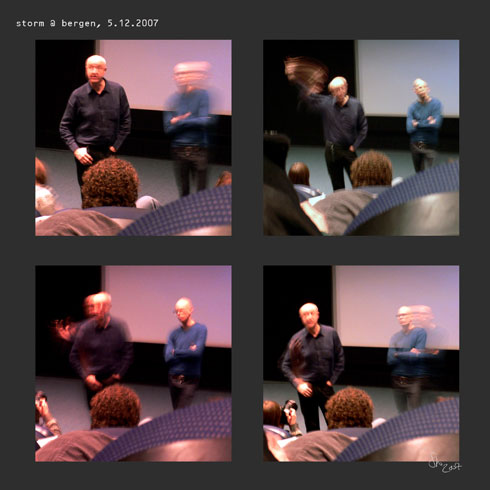Chris Watson, (sometimes with the assistance of Mike Harding from Touch) also gives talks, workshops and demonstrations of his work. Together they established a course at the Royal College of Art in Stockholm, have lectured widely in the UK, Belgium, Norway and many other places.
He also has produced various installations for festivals in Berlin, York, Oslo, Tokyo and various other cities. Here are some examples from 2007 and 2008…
BA FESTIVAL, YORK, SEPTEMBER 2007
A full programme for this festival can be found here
‘THE SOUND OF SANCTUARY’, an installation will appear at Holy Trinity Church, Goodramgate, throughout the festival.
Tropical rain forests hold a special place in our imaginations. They sustain myriad life forms yet retain a mysterious sense of presence. A place of marvels where we sometimes fear to tread. Chris Watson, one of the world’s greatest sound artists and sound recordists has produced, in real time, ‘The Sound of Sanctuary’, re-creating the sounds and atmosphere to be experienced at sunrise in the Amber Mountain rain forest of Northern Madagascar within the beautiful acoustics of Holy Trinity church at Goodramgate. This will be a contemplative installation which combines some of the common elements of these two very different sites to produce an inspiring and reflective soundscape. The internal architecture and sound of Holy Trinity has similarities to the deep forest acoustic of dense tropical rain forest. Specially recorded location surround sound will fill the space and immerse the listener in the slow drip of time. The sounds of one ancient place played in another. Come inside and take a walk in one of the most remarkable habitats on earth.
‘MIDNIGHT AT THE OASIS’ – LIVE, at the Marquee in Parliament Street on 13th September 2007
The Kalahari desert is a vast open space where over 85% of the wildlife is nocturnal. After sunset the dunes, grasses and thorn bushes are patrolled by an alien empire – the insects. ‘Midnight at the Oasis’ presents an unseen soundscape from a beautiful and hostile environment. In a live mixing Chris Watson, one of the world’s greatest sound artists and sound recordists, will create a 20 minute time compression from sunset to sunrise in South Africa’s Kalahari desert. Within the neutral acoustic space of a canvass marquee in the centre of York the listener will be transported and then surrounded by the unique and delicate nocturnal sonic detail recorded in this remote habitat.
THE WILD EAST
An exhibition of photography by Chris Gomersall, Brancaster Staithe Village Hall, Norfolk
Friday 26th October to Sunday 28th October 2007 10.00 to 17.00 daily
Chris Gomersall, one of the country’s foremost nature photographers, presents his personal view of wildest East Anglia, depicting birds and wildlife from the murkiest mudflats of the Wash to the manicured fields of cereal city. Accompanied by a rich supporting soundscape from the BAFTA award-winning sound recordist Chris Watson. Archival, limited edition giclée prints and canvases will be available for purchase. [Sponsored by ACTPIX Ltd.]
EDVARD GRIEG CENTENARY CELEBRATIONS
Chris Watson takes part in Sleppet, part of the Edvard Grieg Centenary celebrations in Norway. More information can be found here
WILDEYE SOUND RECORDING COURSE
(taught by Chris Watson)
We are pleased to announce the dates for the next Wildlife Sound Recording Courses with Chris Watson: 7-9 Dec 2007 14-16 Dec 2007
We have a long waiting list for these courses and places can only be allocated first-come-first-served – so we advise you to book as soon as possible if you are interested. Initially email info@wildeye.co.uk to check if there are places available stating the weekend of your choice or whether either is possible. If there is a place you will be requested to confirm the booking with a £25 deposit. The importance of the sound track and the role of the sound recordist is often over-looked in the production of wildlife films. The successful recording of wildlife sound, and creation of the film’s sound track is a crucial and major part of the creative process. With new digital equipment available for recording and editing sound it requires skill and experience to do the job justice. This weekend course aims to teach you the skills necessary and give you hands-on experience with some of the latest equipment. The course is suitable for aspiring wildlife film-makers, camera operators, camera assistants, producers and sound recordists. It is taught by Chris Watson, one of the world’s top wildlife sound specialists who regularly works for the BBC.
2008 Lectures & Presentations to Institutions
1. Monday 7th Jan. Lecture/ Presentation at University of West of England to the Bristol Branch Committee of the Institution of Engineering and Technology.
2. Thursday 10th Jan. Seminar at FACT commissioned by Liverpool and Sefton Health Partnership to assist in developing a design guide, outlining the issues that should be considered when approaching the design of new health centres.
3. Wednesday 23rd Jan. York Spacenet; York University, Rymer Auditorium, Conference on Surround Sound.
4. Thursday 24th Jan. Leeds University, School of Music Sound Recording Research Seminar
5. Wednesday 6th Feb. University of West of England, Presentation to Computer, Audio and Music students.
6. Thursday 13th March Leeds College of Music, Location Sounds seminar.
7. Tuesday 22nd/Wednesday 23rd April Ravensbourne College & Chislehurst Caves, Kent, Presentation and field trip to Media students (with Mike Harding)























